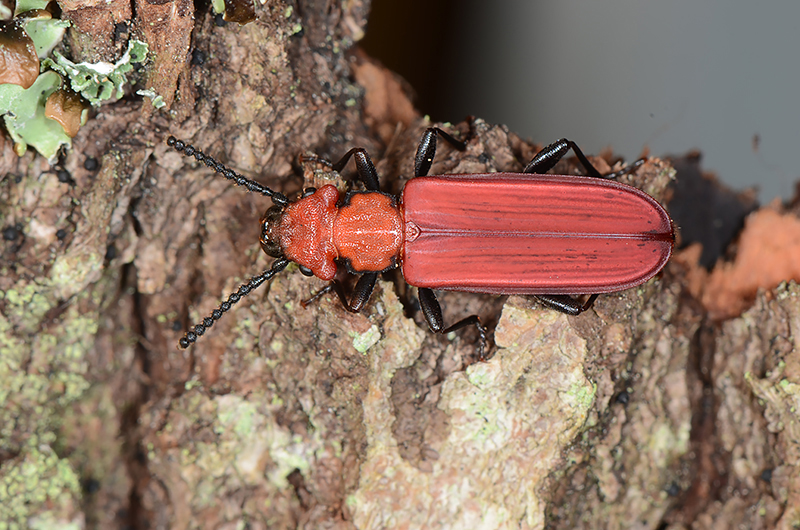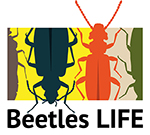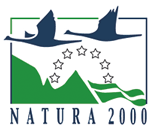Beetles LIFE

One small step for a man, one giant leap for the charismatic flagship species!
Beetles LIFE was a diverse conservation project. It helped eight endangered species of beetle and, above all, their living environment, where hundreds and thousands of other species live. In our project, we told the story of these heroic species, using art, education, the media and games.
Managing the habitats of the target species helps hundreds of other species that inhabit the forests, and it safeguards biodiversity. Nearly half of the all described species are insects. They are vitally important in the food chain and for the ecosystem.
Beetles are great indicators of nature conservation
The target species were the red flat bark beetle Cucujus cinnaberinus, Pytho kolwensis, Boros schneideri, Phryganophilus ruficollis, Stephanopachys linearis, the powder-post beetle Stephanopachys substriatus, Xyletinus tremulicola and Aradus angularis. They are forest indicator species: they effectively reflect the condition of a forest and are at the same time an indicator of nature conservation.
The target species are those listed in Annexes II and IV to the EU Council Directive on the conservation of natural habitats and of wild fauna and flora. That means that the places where they occur need to be made special conservation areas, and the species are also strictly protected outside these areas. The places where they occur and reproduce must not be harmed or destroyed.
The future of these species looks somewhat bleak, though the situation is worse for some than for others. The situation regarding the red flat bark beetle Cucujus cinnaberinus is the most critical of all according to the latest national assessment, and ‘Critically Endangered’ on the IUCN Red List.
More than 950 hectares of beetle habitats have been restored – main outcomes of Beetles LIFE project
Restoration of habitats
- We restored a total of 295 hectares of mire at five different restoration sites.
- We restored commercial forests by burning. A total of 345 hectares of restoration burnings were carried out.
- We increased the amount of decaying wood in 143 hectares.
- We protected by various means the aspen continuum in 168 hectares, i.e. the growth of aspen from seedlings to full-size trees and further into decaying wood.
- The project was active in 26 areas in eight regions of Finland: South Savo, Kanta-Häme, Kainuu, Central Finland, Lapland, North Karelia, North Ostrobothnia and North Savo.
The recovery of habitats after restoration is a slow process, but impacts of restoration burnings are already visible
- During the course of the project, we witnessed how the controlled burning sites attracted the Stephanopachys linearis and Stephanopachys substriatus, the Aradus angularis and the Boros schneideri.
- Altogether, at least 30 species that live in burnt trees arrived at the project’s burned sites already during the project. Among them were several threatened species on the red list. In addition, hundreds of other species living in dead wood arrived at the burned sites.
Comprehensive surveys provide plenty of new information
- We completed management plans for Cucujus cinnaberinus, Pytho kolwensis, Boros schneideri, Phryganophilus ruficollis, Stephanopachys linearis, Stephanopachys substriatus, Xyletinus tremulicola and Aradus angularis.
- We carried out surveys on insects, such as beetles, Hemiptera, Diptera and Hymenoptera, as well as mosses and polypores. We carried out a total of 60 species surveys at 20 different Natura 2000 areas.
- In the insect surveys, we recorded more than 2,500 different insect species in total.
- We found dozens of completely new occurrences of threatened species. At the same time, more than 20 insect species new to Finland were found – some of which were new to science.
- General knowledge of species living in Finland increased. We found 437 species whose red-list status has not been possible to assess due to lack of information.
- The data ensured that the restoration measures of the project do not endanger species. In addition, the data will help to better plan how to help threatened species and what methods are ineffective.
Spreading the word
- We combined art and science in our communications, to get the message across. Here are a few examples:
- Students at the Humak University of Applied Sciences presented the life of beetles at dozens of small and large events, such as Jukola’s relay race and Finnjambore Kajo organized by Guides and Scouts of Finland.
- Two camps brought together researchers and artists for a dialogue on beetles. The artworks created in cooperation were presented at an exhibition organised at the Finnish Museum of Natural Sciences.
- The artists held workshops for about 400 high school students, where they learned responsibility using creativity and research.
- We renewed trails and camping facilities in Koli National Park.
- We trained forestry operators and forest owners about biodiversity.
- How does our work continue after Beetles LIFE project? Read After-LIFE Plan (pdf 3,3 Mb)
- What are the impacts of Beetles LIFE project? Read the Assessment of the impact on socioeconomy and on the ecosystem functions (pdf 4,4 Mb)
Project financing and duration
The budget for the project was EUR 2.69 million, of which 60% (EUR 1.6 million) was funding from the EU’s LIFE Programme.
The project covered the period 1.8.2018–31.7.2023.
The project has received funding from the LIFE Programme of the European Union. The material reflects the views by the authors, and the European Commission or the CINEA is not responsible for any use that may be made of the information it contains.
Last updated 23 September 2024


